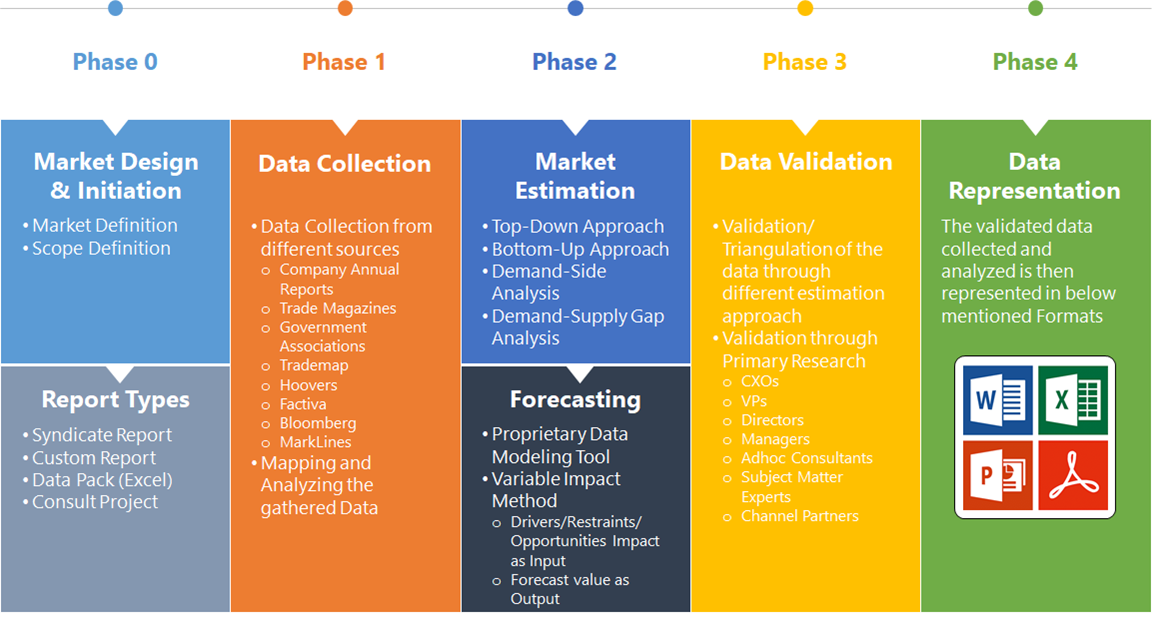Chapter 1. Executive Summary
Chapter 2. Scope Of The Study
2.1. Market Definition
2.2. Scope Of The Study
2.2.1. Objectives of Report
Chapter 3. Evolve BI Methodology
Chapter 4. Market Insights and Trends
4.1. Supply/ Value Chain Analysis
4.2. Porter’s Five Forces Analysis
4.2.1. Threat Of New Entrants
4.2.2. Bargaining Power Of Buyers
4.2.3. Bargaining Power Of Suppliers
4.2.4. Threat Of Substitutes
4.2.5. Industry Rivalry
4.3. Impact of COVID-19 on Electric Trucks Market
4.3.1. Impact on Market Size
4.3.2. End User Trend, Preferences and Budget Impact
4.3.3. Regulatory Framework/Government Policies
4.3.4. Key Players Strategy to Tackle Negative Impact
4.3.5. Opportunity Window
Chapter 5. Market Dynamics
5.1. Introduction
5.2. DRO Analysis
5.2.1. Drivers
5.2.2. Restraints
5.2.3. Opportunities
Chapter 6. Global Electric Trucks Market, By Range
6.1. Introduction
6.2. 0-150 miles
6.3. 151-300 miles
6.4. 300 miles above
Chapter 7. Global Electric Trucks Market, By Propulsion
7.1. Introduction
7.2. Battery electric truck
7.3. Hybrid electric truck
7.4. Plug-in hybrid electric truck
7.5. Fuel cell electric truck
Chapter 8. Global Electric Trucks Market, By Vehicle Type
8.1. Introduction
8.2. Light-duty electric truck
8.3. Medium-duty electric truck
8.4. Heavy-duty electric truck
Chapter 9. Global Electric Trucks Market, By Region
9.1. Introduction
9.2. North America
9.2.1. Introduction
9.2.2. Driving Factors, Opportunity Analyzed and Key Trends
9.2.3. Market Size and Forecast, By Country, 2020 - 2028
9.2.4. Market Size and Forecast, By Range, 2020 - 2028
9.2.5. Market Size and Forecast, By Propulsion, 2020 – 2028
9.2.6. Market Size and Forecast, By Vehicle Type, 2020 – 2028
9.2.7. US
9.2.7.1. Introduction
9.2.7.2. Driving Factors, Opportunity Analyzed and Key Trends
9.2.7.3. Market Size and Forecast, By Range, 2020 - 2028
9.2.7.4. Market Size and Forecast, By Propulsion, 2020 – 2028
9.2.7.5. Market Size and Forecast, By Vehicle Type, 2020 - 2028
9.2.8. Canada
9.2.8.1. Introduction
9.2.8.2. Driving Factors, Opportunity Analyzed and Key Trends
9.2.8.4. Market Size and Forecast, By Range, 2020 - 2028
9.2.8.5. Market Size and Forecast, By Propulsion, 2020 – 2028
9.2.8.6. Market Size and Forecast, By Vehicle Type, 2020 - 2028
9.3. Europe
9.3.1. Introduction
9.3.2. Driving Factors, Opportunity Analyzed and Key Trends
9.3.3. Market Size and Forecast, By Country, 2020 - 2028
9.3.4. Market Size and Forecast, By Range, 2020 - 2028
9.3.5. Market Size and Forecast, By Propulsion, 2020 – 2028
9.3.6. Market Size and Forecast, By Vehicle Type, 2020 – 2028
9.3.7. Germany
9.3.7.1. Introduction
9.3.7.2. Driving Factors, Opportunity Analyzed and Key Trends
9.3.7.3. Market Size and Forecast, By Range, 2020 - 2028
9.3.7.4. Market Size and Forecast, By Propulsion, 2020 – 2028
9.3.7.5. Market Size and Forecast, By Vehicle Type, 2020 - 2028
9.3.8. France
9.3.8.1. Introduction
9.3.8.2. Driving Factors, Opportunity Analyzed and Key Trends
9.3.8.3. Market Size and Forecast, By Range, 2020 - 2028
9.3.8.4. Market Size and Forecast, By Propulsion, 2020 – 2028
9.3.8.5. Market Size and Forecast, By Vehicle Type, 2020 - 2028
9.3.9. UK
9.3.9.1. Introduction
9.3.9.2. Driving Factors, Opportunity Analyzed and Key Trends
9.3.9.3. Market Size and Forecast, By Range, 2020 - 2028
9.3.9.4. Market Size and Forecast, By Propulsion, 2020 – 2028
9.3.9.5. Market Size and Forecast, By Vehicle Type, 2020 - 2028
9.3.10. Italy
9.3.10.1. Introduction
9.3.10.2. Driving Factors, Opportunity Analyzed and Key Trends
9.3.10.3. Market Size and Forecast, By Range, 2020 - 2028
9.3.10.4. Market Size and Forecast, By Propulsion, 2020 – 2028
9.3.10.5. Market Size and Forecast, By Vehicle Type, 2020 - 2028
9.3.11. Rest Of Europe
9.3.11.1. Introduction
9.3.11.2. Driving Factors, Opportunity Analyzed and Key Trends
9.3.11.3. Market Size and Forecast, By Range, 2020 - 2028
9.3.11.4. Market Size and Forecast, By Propulsion, 2020 – 2028
9.3.11.5. Market Size and Forecast, By Vehicle Type, 2020 - 2028
9.4. Asia-Pacific
9.4.1. Introduction
9.4.2. Driving Factors, Opportunity Analyzed and Key Trends
9.4.3. Market Size and Forecast, By Country, 2020 - 2028
9.4.4. Market Size and Forecast, By Range, 2020 - 2028
9.4.5. Market Size and Forecast, By Propulsion, 2020 – 2028
9.4.7. Market Size and Forecast, By Vehicle Type, 2020 - 2028
9.4.8. China
9.4.8.1. Introduction
9.4.8.2. Driving Factors, Opportunity Analyzed and Key Trends
9.4.8.3. Market Size and Forecast, By Range, 2020 - 2028
9.4.8.4. Market Size and Forecast, By Propulsion, 2020 – 2028
9.4.8.5. Market Size and Forecast, By Vehicle Type, 2020 - 2028
9.4.9. India
9.4.9.1. Introduction
9.4.9.2. Driving Factors, Opportunity Analyzed and Key Trends
9.4.9.3. Market Size and Forecast, By Range, 2020 - 2028
9.4.9.4. Market Size and Forecast, By Propulsion, 2020 – 2028
9.4.9.5. Market Size and Forecast, By Vehicle Type, 2020 - 2028
9.4.10. Japan
9.4.10.1. Introduction
9.4.10.2. Driving Factors, Opportunity Analyzed and Key Trends
9.4.10.3. Market Size and Forecast, By Range, 2020 - 2028
9.4.10.4. Market Size and Forecast, By Propulsion, 2020 – 2028
9.4.10.5. Market Size and Forecast, By Vehicle Type, 2020 - 2028
9.4.11. South Korea
9.4.11.1. Introduction
9.4.11.2. Driving Factors, Opportunity Analyzed and Key Trends
9.4.11.3. Market Size and Forecast, By Range, 2020 - 2028
9.4.11.4. Market Size and Forecast, By Propulsion, 2020 – 2028
9.4.11.5. Market Size and Forecast, By Vehicle Type, 2020 - 2028
9.4.12. Rest Of Asia-Pacific
9.4.11.1. Introduction
9.4.12.2. Driving Factors, Opportunity Analyzed and Key Trends
9.4.12.3. Market Size and Forecast, By Range, 2020 - 2028
9.4.12.4. Market Size and Forecast, By Propulsion, 2020 – 2028
9.4.12.5. Market Size and Forecast, By Vehicle Type, 2020 - 2028
9.5. Rest Of The World (RoW)
9.5.1. Introduction
9.5.2. Driving Factors, Opportunity Analyzed and Key Trends
9.5.3. Market Size and Forecast, By Range, 2020 - 2028
9.5.4. Market Size and Forecast, By Propulsion, 2020 – 2028
9.5.5. Market Size and Forecast, By Vehicle Type, 2020 - 2028
9.5.6. Market Size and Forecast, By Region, 2020 - 2028
9.5.7. South America
9.5.7.1. Introduction
9.5.7.2. Driving Factors, Opportunity Analyzed and Key Trends
9.5.7.3. Market Size and Forecast, By Range, 2020 - 2028
9.5.7.4. Market Size and Forecast, By Propulsion, 2020 – 2028
9.5.7.5. Market Size and Forecast, By Vehicle Type, 2020 - 2028
9.5.8. Middle East & Africa
9.5.8.1. Introduction
9.5.8.2. Driving Factors, Opportunity Analyzed and Key Trends
9.5.8.3. Market Size and Forecast, By Range, 2020 - 2028
9.5.8.4. Market Size and Forecast, By Propulsion, 2020 – 2028
9.5.8.5. Market Size and Forecast, By Vehicle Type, 2020 - 2028
Chapter 10. Competitive Landscape
10.1. Introduction
10.2. Vendor Share Analysis, 2020/Key Players Positioning 2020
Chapter 11. Company Profiles
11.1. AB VOLVO
11.1.1. Business Overview
11.1.2. Financial Analysis
11.1.3. Product Portfolio
11.1.4. Recent Development and Strategies Adopted
11.1.5. SWOT Analysis
11.2. BYD Company Ltd.
11.2.1. Business Overview
11.2.2. Financial Analysis
11.2.3. Product Portfolio
11.2.4. Recent Development and Strategies Adopted
11.2.5. SWOT Analysis
11.3. DAIMLER
11.3.1. Business Overview
11.3.2. Financial Analysis
11.3.3. Product Portfolio
11.3.4. Recent Development and Strategies Adopted
11.3.5. SWOT Analysis
11.4. MAN
11.4.1. Business Overview
11.4.2. Financial Analysis
11.4.3. Product Portfolio
11.4.4. Recent Development and Strategies Adopted
11.4.5. SWOT Analysis
11.5. SCANIA
11.5.1. Business Overview
11.5.2. Financial Analysis
11.5.3. Product Portfolio
11.5.4. Recent Development and Strategies Adopted
11.5.5. SWOT Analysis
11.6. Dongfeng Motor Group Co., Ltd
11.6.1. Business Overview
11.6.2. Financial Analysis
11.6.3. Product Portfolio
11.6.4. Recent Development and Strategies Adopted
11.6.5. SWOT Analysis
11.7. Rivian
11.7.1. Business Overview
11.7.2. Financial Analysis
11.7.3. Product Portfolio
11.7.4. Recent Development and Strategies Adopted
11.7.5. SWOT Analysis
11.8. Tata Motors
11.8.1. Business Overview
11.8.2. Financial Analysis
11.8.3. Product Portfolio
11.8.4. Recent Development and Strategies Adopted
11.8.5. SWOT Analysis
11.9. Tesla
11.9.1. Business Overview
11.9.2. Financial Analysis
11.9.3. Product Portfolio
11.9.4. Recent Development and Strategies Adopted
11.9.5. SWOT Analysis
11.10. Workhorse
11.10.1. Business Overview
11.10.2. Financial Analysis
11.10.3. Product Portfolio
11.9.4. Recent Development and Strategies Adopted
11.9.5. SWOT Analysis
Chapter 12. Key Takeaways






